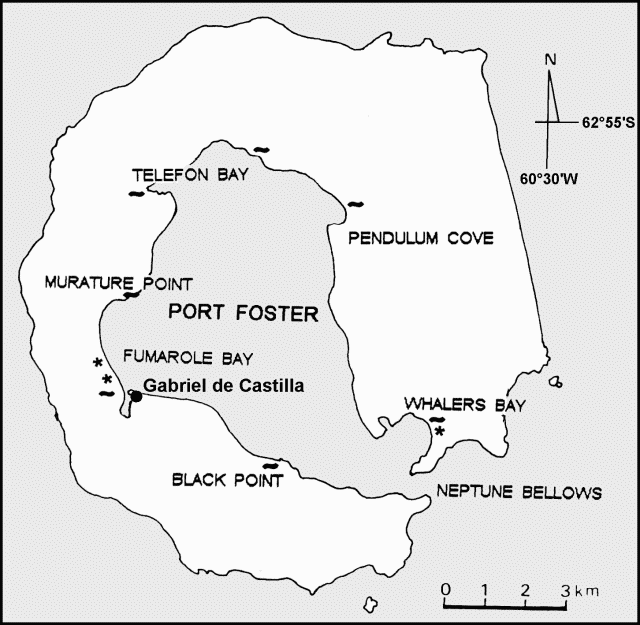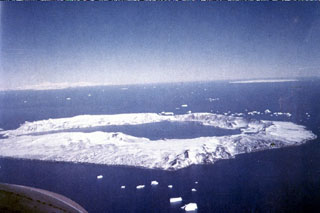Report on Deception Island (Antarctica) — May 1998
Bulletin of the Global Volcanism Network, vol. 23, no. 5 (May 1998)
Managing Editor: Richard Wunderman.
Deception Island (Antarctica) Stable conditions, 35 hours of tremor
Please cite this report as:
Global Volcanism Program, 1998. Report on Deception Island (Antarctica) (Wunderman, R., ed.). Bulletin of the Global Volcanism Network, 23:5. Smithsonian Institution. https://doi.org/10.5479/si.GVP.BGVN199805-390030
Deception Island
Antarctica
62.9567°S, 60.6367°W; summit elev. 602 m
All times are local (unless otherwise noted)
A Deception Volcano Observatory team has visited the island every austral summer since 1986. In comparison with measurements made during 1996-1997, the temperatures of fumaroles and hot soils generally remained stable: 96-98°C in Fumarole Bay, 64°C in Whaler's Bay, 43°C in Telefon Bay, and 60°C in Pendulum Cove. At Murature Point an increase of more than 20°C produced greater bubbling under the sea, and a large quantity of dead (boiled) krill at the shoreline.
Fumarolic gases were mainly composed of CO2 and H2S, similar to previous years. SO2 was not detected.
Seismicity was monitored with a digital seismic array having 16-bit dynamic range. The array included 6 vertical-component geophones (Mark L25B) located near the Spanish Antarctic Station Gabriel de Castilla (figure 12). Figure 13 shows seismic data collected from 18 December 1997 to 24 February 1998. A significant component of the seismicity was volcanic tremor of a few minutes to several hours duration totaling 35 hours over the reporting period. Also recorded were 72 hybrid events, 291 long-period events, 12 short-period events, and some regional events generated at 30-100 km distance. Recorded seismicity during this period was greater in both energy and number than in previous years.
 |
Figure 12. Map of Deception Island, showing fumaroles (*) and hot soils (~) in 1998. Courtesy of C. Risso. |
Geological Summary. Ring-shaped Deception Island, at the SW end of the South Shetland Islands, NE of Graham Land Peninsula, was constructed along the axis of the Bransfield Rift spreading center. A narrow passageway named Neptunes Bellows provides an entrance to a natural harbor within the 8.5 x 10 km caldera that was utilized as an Antarctic whaling station. Numerous vents along ring fractures circling the low 14-km-wide island have been reported active for more than 200 years. Maars line the shores of 190-m-deep Port Foster caldera bay. Among the largest of these maars is 1-km-wide Whalers Bay, at the entrance to the harbor. Eruptions during the past 8,700 years have been dated from ash layers in lake sediments on the Antarctic Peninsula and neighboring islands.
Information Contacts: C. Risso, Observatorio Volcanológico Decepción, Instituto Antártico Argentino-UBA, Cerrito 1248 (1010) Buenos Aires, Argentina; A. García, R. Abella, and J. Peña, Dpto. Volcanologia, Museo Nacional de Ciencias Naturales-CSIS, José Guiterrez Abascal 2, 28006 Madrid-Spain; E. Vélez, Instituto de Astronomía y Geodesia-CSIS, Madrid-Spain; F. Navarro, Escuela Superior de Ingenieros de Telecomunicaciones-U.P.M., Madrid, Spain.


